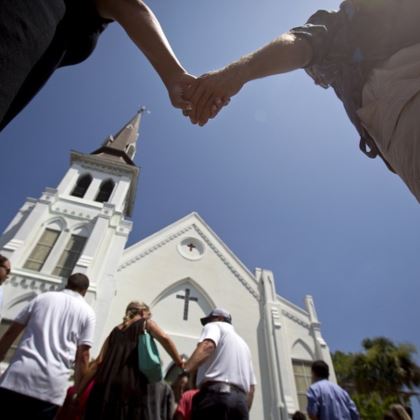

People hold hands during morning service at Emanuel AME Church in Charleston, S.C., June 21, 2015. (Reuters)
VOA Special Report
House of Worship shootings
Mass shootings at churches, temples, synagogues and mosques have become more frequent since the mid-2000s
Mass shootings (1966 - February 2020)
The first mass shooting at a house of worship in the modern era occurred in 1980 during Sunday services at First Baptist Church in Daingerfield, Texas.
Five people were killed and 10 others were injured. The shooting was prompted by revenge involving a criminal domestic issue.
Mass shootings are defined by the Congressional Research Service as having four or more victims.
Since the mid-2000s, mass shootings in churches, temples, synagogues and mosques have become more frequent, and been committed by perpetrators with a history of racism, anti-Semitism, anti-Christianity and Islamophobia, with ties to white supremacist and neo-Nazi groups.
From 1966 to 2000, only 1% of mass shootings were motivated by religious hate. After that, the number escalated. From 2000 to 2014, 9% of mass shootings involved religious hate. That number jumped to 17% between 2018 and February 2020.
The Violence Project classified worship mass shooters in two distinct groups: those motivated by anti-Semitism, Islamophobia or anti-Christianity, who were not members of the congregation where they committed their crime; and those motivated by domestic issues whose spouse, girlfriend or other family members belonged to a congregation where the attack occurred.
In 2012, six people at the Sikh Temple of Wisconsin in the town of Oak Creek were shot to death by a 41-year-old white supremacist who had discussed a racial holy war. One of the injured victims died in 2020 from his head wound, becoming the seventh fatality.
Igniting a race war was the confessed motive of the 25-year-old white supremacist and neo-Nazi who killed nine black parishioners in 2015 at Emanuel African Methodist Episcopal Church in Charleston, South Carolina — the oldest black church in the South.
In 2018, 11 Jews attending services at the Tree of Life synagogue in Pittsburgh, Pennsylvania, were fatally shot by a white supremacist with a history of anti-Semitism.
A family feud is believed to have prompted the deadliest mass shooting in modern Texas history, as well as at a house of worship, in 2017. Twenty-six people, half of them children and one unborn, were killed at First Baptist Church in Sutherland Springs, Texas.
House of worship mass shooting locations Fatalities and house of worship mass shootings
Circles scaled according to the number of fatalities.
Jillian Peterson, Ph.D., and James Densley, Ph.D., built a new database of mass shooters that they hope will inform future research and policy decisions about how to effectively prevent and respond to mass shootings.
For their study, they used the Congressional Research Service’s definition of a mass shooting:
“a multiple homicide incident in which four or more victims are murdered with firearms — not including the offender(s) — within one event, and at least some of the murders occurred in a public location or locations in close geographical proximity (e.g., a workplace, school, restaurant, or other public settings), and the murders are not attributable to any other underlying criminal activity or commonplace circumstance (armed robbery, criminal competition, insurance fraud, argument, or romantic triangle).”
About the data
All shooters have either been charged, convicted or killed at the scene.
The team collected more than 100 pieces of information on each of 172 mass shooters, resulting in The Violence Project Database of Mass Shootings in the United States, 1966 - February 2020.
They compiled details on hundreds of factors, including age, race, gender, nationality, sexual orientation, religion, education, relationship status, number of children, employment type and status, military service and branch, criminal, violence and abuse history, gang and terrorist affiliation, bullying, home environment and trauma.
What emerged were fleshed-out profiles and motivations of individual shooters, whose crimes can potentially influence current and future policy and prevention.
House of Worship shootings (1966 - February 2020)
While there is no single profile of a mass shooter, there are several similar characteristics of shooters who commit crimes at houses of worship.
Almost three-quarters were white, and all were men. Sixty-four percent were single. Nearly two-thirds had criminal records and a violent history. And nearly two-thirds had experienced serious childhood trauma.
Number of shooters by age
Years old
A house of worship shooter is described by The Violence Project as a suicidal white male in his 40s who used a handgun in a Christian church. Almost half of them were motivated by religious hate and half knew at least one of their victims.
Twenty-seven percent of perpetrators in house of worship shootings expressed racism toward people of color, and 46% were motivated by religious hate, which includes anti-Semitism, Islamophobia, and anger at Christianity/Christians.
Eighteen percent had broken up or separated from their spouses or partners.
Sixty-four percent of all worship shootings took place in Southern states. Texas had the most, with four, followed by Louisiana, with two, and South Carolina, with one. Wisconsin was the only non-Southern state that had two mass shootings — one in Oak Creek, and an earlier one at the Living Church of God in Brookfield. Colorado and Pennsylvania each had one mass shooting.